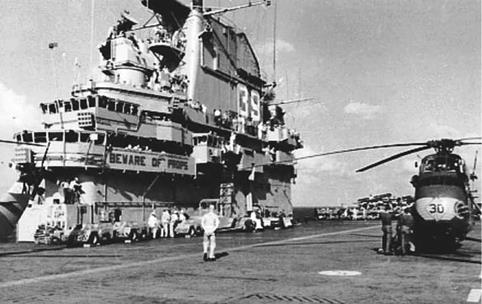EYEWITNESSES TO HISTORY
The day of the MR-3 launch left Ed Killian with many memories. “Air Boss Howard Skidmore was in Pri-Fly with his several cameras. I’d never seen so many observers on the island’s superstructure.[2] Every exterior catwalk – every vantage point – was crammed with photographers, reporters, scientists, NASA technicians, and military representatives of all the branches. The crew appeared to be going about its regular routine. There were no more personnel visible on deck than would have been on duty for regular flight operations. Then came an announcement from the ship’s 1MC [the main circuit] loudspeaker that the astronaut was in the capsule and the launch was counting down. The announcement then said that the crew was permitted topside on the flight deck to view the [splashdown] event.” They were to observe the recovery standing aft of a raised arresting gear cable, and aft of the island. Marine guards had been posted opposite the crew to keep them from moving forward prior to the arrival of the Marine helicopter bearing the spacecraft – more as a matter of safety than one of security.
“Following this progress report on the 1MC, the ship’s crew suddenly started to appear on the flight deck. They literally poured out of every hatch, filled every deck catwalk and spilled onto the flight deck. Hundreds of them, in all manner of jersey colors; red for gas handlers and ordnance men; yellow for plane directors; green for electricians and aviation technicians; blue for plane spotters; brown for ship’s hangar deck crews. Sailors in blue dungarees, cooks in cook-caps, the dirtiest First Division bosuns, and sailors of every discipline on the ship poured out onto the flight deck aft of the island, their eyes agog at all the activity on the forward flight deck area. Some crew members whose duty stations were on the island were able to get on the island catwalks to observe the recovery.”
With the launch imminent, Marine Corps Sikorsky HUS-1 Seahorse helicopters on the deck forward of the island were prepped for liftoff, ready to proceed to the recovery site which was expected to be several miles off the carrier’s port bow.
Marine Corps lieutenants Wayne Koons from Lyons, Kansas, and George Cox from Eustis, Florida, had been attached to squadron HMR(L)-262. They were aboard
|
The island structure of the USS Lake Champlain on 5 May 1961. (Photo courtesy of Ed Killian) |
“The Champ” on temporary assigned duty, having been selected to fly the primary recovery helicopter. Two other Marine Corps choppers were also in the same flight, and ready to act in a backup capacity if necessary. Koons had participated in three previous at-sea retrievals; two as copilot and one as pilot. Cox had been involved in the recovery of the MR-2 capsule that carried chimpanzee Ham on 31 January, just three months earlier. About two months prior to the flight of MR-3, Koons and Cox had participated in live training with Shepard, Gus Grissom and John Glenn. In this training the egress trainer was placed in the “back river” at Langley AFB, Virginia, with an astronaut inside. Three live retrievals were made, one with each astronaut, in this calm water environment.











